INSTITUT SUPERIEUR D'ANTHROPOLOGIE
INSTITUTE OF ANTHROPOLOGY
ONLINE COURSES / COURS A DISTANCE
FALL TERM : OCTOBER 2015
REGISTER NOW
ROYAUME UNI – 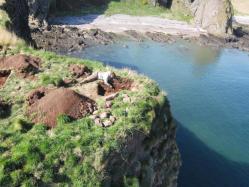 Dunnicaer - A Pictish fort on an inhospitable sea stack is believed to be the oldest in Scotland, archaeologist have said. Carbon dating from the site south of Stonehaven in Aberdeenshire suggests it dates from the third or fourth century, making it the oldest Pictish fort ever discovered. Archaeologists from the University of Aberdeen needed help from experienced mountaineers to scale the rocky outcrop, which measures at most 20 by 12 metres and is surrounded by sheer drops on all sides.Once on the site, known as Dunnicaer, they dug five trenches which yielded a number of finds, including evidence of fortified enclosure walls and terraces and the remains of a stone hearth. Dr Noble said Dunnicaer appears to have been home to a "significant fort", with ramparts constructed of timber and stone. He added: "The stone is not from the local area so it must have been quite a feat to get it, and the heavy oak timbers, up to such an inaccessible site. "It is likely that the sea stack was greater in size than it is today as the fort appears to extend over a large area. Dunnicaer was likely to have been a high status site for a structure of this scale and complexity to have been present as early as the 3rd century." However results of the carbon dating suggest that use of Dunnicaer was relatively short-lived and it is assumed the Pictish communities who inhabited it moved on to the larger site of Dunnottar Castle to the south.
Dunnicaer - A Pictish fort on an inhospitable sea stack is believed to be the oldest in Scotland, archaeologist have said. Carbon dating from the site south of Stonehaven in Aberdeenshire suggests it dates from the third or fourth century, making it the oldest Pictish fort ever discovered. Archaeologists from the University of Aberdeen needed help from experienced mountaineers to scale the rocky outcrop, which measures at most 20 by 12 metres and is surrounded by sheer drops on all sides.Once on the site, known as Dunnicaer, they dug five trenches which yielded a number of finds, including evidence of fortified enclosure walls and terraces and the remains of a stone hearth. Dr Noble said Dunnicaer appears to have been home to a "significant fort", with ramparts constructed of timber and stone. He added: "The stone is not from the local area so it must have been quite a feat to get it, and the heavy oak timbers, up to such an inaccessible site. "It is likely that the sea stack was greater in size than it is today as the fort appears to extend over a large area. Dunnicaer was likely to have been a high status site for a structure of this scale and complexity to have been present as early as the 3rd century." However results of the carbon dating suggest that use of Dunnicaer was relatively short-lived and it is assumed the Pictish communities who inhabited it moved on to the larger site of Dunnottar Castle to the south.
http://www.heraldscotland.com/news/13503688.Archaeologists_unearth__oldest_Pictish_fort_in_Scotland__on_Aberdeenshire_sea_stack/
GRECE – 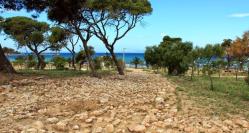 Vouliagmeni - Greek Culture Ministry officials recently announced that archaeologists discovered a 300-meter long stretch of an ancient carriage road during excavations at Megalo Kavouri beach in Vouliagmeni, Athens. The ancient pathway, which is approximately 300 meters long and 1.90 to 6.10 meters wide is considered to have been used during the 4th century BC to connect the ancient municipality of Aixonidon Alon to the ancient port. The carriage road, which was paved with stones and supported by retaining walls on both sides, was connected to a greater road network that included a road linking Athens with Sounion and a road from the Faliro coast to Voula.
Vouliagmeni - Greek Culture Ministry officials recently announced that archaeologists discovered a 300-meter long stretch of an ancient carriage road during excavations at Megalo Kavouri beach in Vouliagmeni, Athens. The ancient pathway, which is approximately 300 meters long and 1.90 to 6.10 meters wide is considered to have been used during the 4th century BC to connect the ancient municipality of Aixonidon Alon to the ancient port. The carriage road, which was paved with stones and supported by retaining walls on both sides, was connected to a greater road network that included a road linking Athens with Sounion and a road from the Faliro coast to Voula.
http://greece.greekreporter.com/2015/07/27/ancient-carriage-road-unearthed-in-vouliagmeni-greece/
FRANCE – 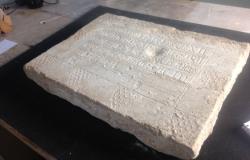 Toulouse - Jean Dominique était notaire et accessoirement prêteur sur gages à une époque où l’on ne faisait pas de vieux os. Pourtant ce n’est a priori pas son métier qui a dû mener l’homme de vie à trépas le 12 avril 1283. Son épitaphe a été retrouvée en bon état la semaine dernière lors des fouilles réalisées autour de la basilique Saint-Sernin par le service archéologique de Toulouse Métropole de l’aménagement futur de la place. Cette pierre funéraire avait été recyclée au XIXe siècle pour la construction d’un mur, au sein de l’ancien cloître de Saint-Sernin. Une découverte rare vu l’état de l’épitaphe qui permet aux chercheurs d’affiner leur connaissance sur l’histoire de la Ville rose au Moyen-Age. « Cet homme, aussi juriste, est mentionné à plusieurs reprises comme étant de l’entourage du comte de Toulouse, Alphonse de Poitiers. Nous avions déjà retrouvé son testament aux archives municipales. Il habitait l’actuelle rue du Taur et avait été membre d’une ambassade pour défendre les repentis de l’hérésie cathare », détaille Pierre Pisani, le responsable du service. Ce n’est pas la seule trouvaille faite depuis le début de la campagne de fouilles commencée mi juin et qui doit s’achever le 15 août. Outre le cloître, retrouvé en assez mauvais état, les archéologues ont mis au jour « énormément de sépultures du Moyen Age », précise Pierre Pisani. Et à l’époque, les cimetières étaient bien distincts. Ceux des nobles, mais aussi des enfants et des pèlerins ont pu être observés. En revanche, nulle trace de la nécropole néolithique sur laquelle ces spécialistes de la truelle pensaient tomber.
Toulouse - Jean Dominique était notaire et accessoirement prêteur sur gages à une époque où l’on ne faisait pas de vieux os. Pourtant ce n’est a priori pas son métier qui a dû mener l’homme de vie à trépas le 12 avril 1283. Son épitaphe a été retrouvée en bon état la semaine dernière lors des fouilles réalisées autour de la basilique Saint-Sernin par le service archéologique de Toulouse Métropole de l’aménagement futur de la place. Cette pierre funéraire avait été recyclée au XIXe siècle pour la construction d’un mur, au sein de l’ancien cloître de Saint-Sernin. Une découverte rare vu l’état de l’épitaphe qui permet aux chercheurs d’affiner leur connaissance sur l’histoire de la Ville rose au Moyen-Age. « Cet homme, aussi juriste, est mentionné à plusieurs reprises comme étant de l’entourage du comte de Toulouse, Alphonse de Poitiers. Nous avions déjà retrouvé son testament aux archives municipales. Il habitait l’actuelle rue du Taur et avait été membre d’une ambassade pour défendre les repentis de l’hérésie cathare », détaille Pierre Pisani, le responsable du service. Ce n’est pas la seule trouvaille faite depuis le début de la campagne de fouilles commencée mi juin et qui doit s’achever le 15 août. Outre le cloître, retrouvé en assez mauvais état, les archéologues ont mis au jour « énormément de sépultures du Moyen Age », précise Pierre Pisani. Et à l’époque, les cimetières étaient bien distincts. Ceux des nobles, mais aussi des enfants et des pèlerins ont pu être observés. En revanche, nulle trace de la nécropole néolithique sur laquelle ces spécialistes de la truelle pensaient tomber.
http://www.20minutes.fr/toulouse/1658131-20150727-toulouse-sous-paves-saint-sernin-ancetres-moyen-age
PAKISTAN – 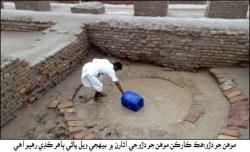 Mohenjo Daro- According to reports, the monumental world heritage site faces serious threat from recent very heavy rainfall and at some places the rainwater has entered in the city, which is said to be around 5000 years old. Some portions of the historic archaeological site have already been swept away by the rainwater, while others face serious danger from the ravages of rainfall and flooding, local people said. According to archaeologists the world’s first planned city was destroyed at least seven times by floods in its ancient history, the tragedy could revisit it again. Located on the bank of Indus River in Pakistan’s southern province of Sindh, Mohenjodaro was built around 2400 BC. It was destroyed at least seven times by the floods and rebuilt on the top of ruins each time, experts said. Mohenjo Daro, around two kilometres from the river, was discovered during excavations in 1922. Regarded as the oldest planned city in the world, the site covers an area of about 240 hectares, but so far only 10 per cent of it has been excavated. UNESCO had launched an international campaign to buttress Mohenjo Daro against floods that completed in 1997 after an investment of about eight million dollars. Five spurs built along the river banks at an average height of six metres protected the city during 1992 floods.
Mohenjo Daro- According to reports, the monumental world heritage site faces serious threat from recent very heavy rainfall and at some places the rainwater has entered in the city, which is said to be around 5000 years old. Some portions of the historic archaeological site have already been swept away by the rainwater, while others face serious danger from the ravages of rainfall and flooding, local people said. According to archaeologists the world’s first planned city was destroyed at least seven times by floods in its ancient history, the tragedy could revisit it again. Located on the bank of Indus River in Pakistan’s southern province of Sindh, Mohenjodaro was built around 2400 BC. It was destroyed at least seven times by the floods and rebuilt on the top of ruins each time, experts said. Mohenjo Daro, around two kilometres from the river, was discovered during excavations in 1922. Regarded as the oldest planned city in the world, the site covers an area of about 240 hectares, but so far only 10 per cent of it has been excavated. UNESCO had launched an international campaign to buttress Mohenjo Daro against floods that completed in 1997 after an investment of about eight million dollars. Five spurs built along the river banks at an average height of six metres protected the city during 1992 floods.
http://arynews.tv/en/historic-mohen-jo-daro-faces-serious-threat-from-rainwater
AZERBAIDJAN –  Barda - A number of archeological finds have surfaced at the Shortepe monument situated 5 km away from the Barda district center. As a result of the excavations carried out by the Bard archeological expedition, a variety of items estimated to date back to the seventh century B.C. have been discovered,APA’s Garabagh bureau said. Prof. Arif Mammadov, head of the Barda expedition of the Archeology and Ethnography Institute of the National Academy of Sciences of Azerbaijan, said they have found walls as wide as 4 meters and cultural items belonging to the seventh century B.C. The archeologist says that based on the results of a series of excavations carried out a few years ago at the Shortepe monument they estimate Bard might have been a highly civilized place in the middle of the 1st millennium B.C., adding that the ancient city of Barda emerged as a result of craftsmanship diverging from cattle breeding and farming. “Considering this process began in the mid-second millennium B.C., it becomes clear once more that the city is at least 3,000 years old. During excavations we are able to follow the city’s history in three layers. The top layer dates back to the 9-10th centuries, the second layer to the 2nd to 8th centuries, and the third layer to the 7th century B.C. to the 3rd century A.D.,” said Arif Mammadov.
Barda - A number of archeological finds have surfaced at the Shortepe monument situated 5 km away from the Barda district center. As a result of the excavations carried out by the Bard archeological expedition, a variety of items estimated to date back to the seventh century B.C. have been discovered,APA’s Garabagh bureau said. Prof. Arif Mammadov, head of the Barda expedition of the Archeology and Ethnography Institute of the National Academy of Sciences of Azerbaijan, said they have found walls as wide as 4 meters and cultural items belonging to the seventh century B.C. The archeologist says that based on the results of a series of excavations carried out a few years ago at the Shortepe monument they estimate Bard might have been a highly civilized place in the middle of the 1st millennium B.C., adding that the ancient city of Barda emerged as a result of craftsmanship diverging from cattle breeding and farming. “Considering this process began in the mid-second millennium B.C., it becomes clear once more that the city is at least 3,000 years old. During excavations we are able to follow the city’s history in three layers. The top layer dates back to the 9-10th centuries, the second layer to the 2nd to 8th centuries, and the third layer to the 7th century B.C. to the 3rd century A.D.,” said Arif Mammadov.
http://en.apa.az/-_230180.html
BULGARIE – 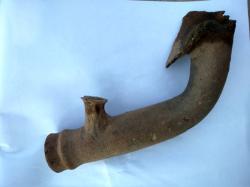 Lyutitsa - Archaeologists recently discovered an 11th century fragment of a distillation vessel used for the production of the country's traditional fruit brandy, which is known as rakia. The fragment was uncovered during the excavation works, which are being conducted by the National Historical Museum (NIM) at the medieval Lyutitsa fortress. The fortress is situated on a hill above the town of Ivaylovgrad and the find was discovered by the team of archaeologist Filip Petrunov, press statement of NIM informs. This is the second vessel for the distillation of rakia to be uncovered at the fortress and the third one in Bulgaria. The first vessel at Lyutitsa was found in 2011, while the other one was uncovered in the medieval fortress of Drastar, which is located in the town of Silistra. All three distillation vessels are dated back to the 11th century, which raises an important point in the ongoing historical debate on tracing back the start of rakia production. Until recently, historians argued that the production of rakia had started only in the 16th century. However archaeologist Prof. Konstantin Totev discovered five years ago a fragment of a cup dating back to the 14th century. The cup bears an inscription of an unknown Bulgarian, who boasted that he had drank rakia at a religious holiday back then. Another archaeologist, Prof. Nikolay Ovcharov, published the justification of the military commander Lala Sahin Pasha to the Ottoman Sultan for his failure to storm the fortress of Sofia in 1382. The Ottoman commander complained that Sofia was defended by tough Bulgarians, who would drink rakia before the fight and thus became invincible. http://www.novinite.com/articles/170063/Bulgarian+Archaeologists+Discover+11th+Century+Rakia+Distillation+Vessel#sthash.2c3DPDfP.dpuf
Lyutitsa - Archaeologists recently discovered an 11th century fragment of a distillation vessel used for the production of the country's traditional fruit brandy, which is known as rakia. The fragment was uncovered during the excavation works, which are being conducted by the National Historical Museum (NIM) at the medieval Lyutitsa fortress. The fortress is situated on a hill above the town of Ivaylovgrad and the find was discovered by the team of archaeologist Filip Petrunov, press statement of NIM informs. This is the second vessel for the distillation of rakia to be uncovered at the fortress and the third one in Bulgaria. The first vessel at Lyutitsa was found in 2011, while the other one was uncovered in the medieval fortress of Drastar, which is located in the town of Silistra. All three distillation vessels are dated back to the 11th century, which raises an important point in the ongoing historical debate on tracing back the start of rakia production. Until recently, historians argued that the production of rakia had started only in the 16th century. However archaeologist Prof. Konstantin Totev discovered five years ago a fragment of a cup dating back to the 14th century. The cup bears an inscription of an unknown Bulgarian, who boasted that he had drank rakia at a religious holiday back then. Another archaeologist, Prof. Nikolay Ovcharov, published the justification of the military commander Lala Sahin Pasha to the Ottoman Sultan for his failure to storm the fortress of Sofia in 1382. The Ottoman commander complained that Sofia was defended by tough Bulgarians, who would drink rakia before the fight and thus became invincible. http://www.novinite.com/articles/170063/Bulgarian+Archaeologists+Discover+11th+Century+Rakia+Distillation+Vessel#sthash.2c3DPDfP.dpuf